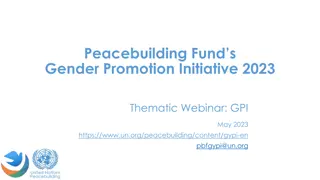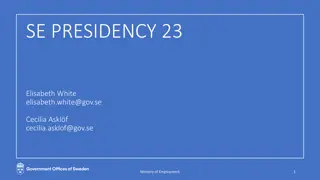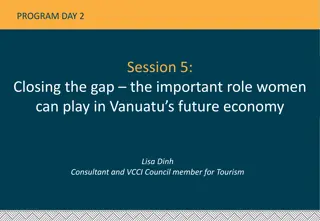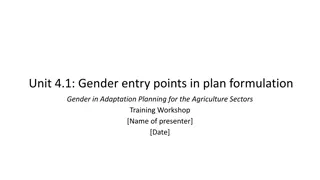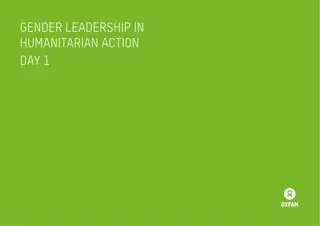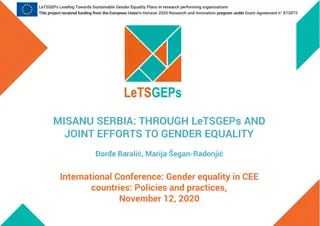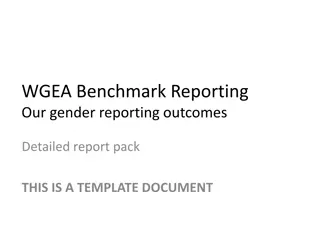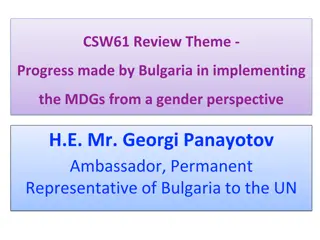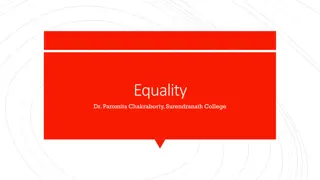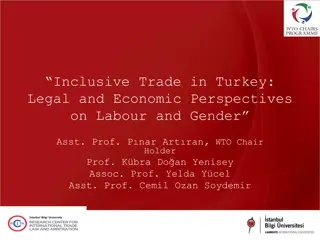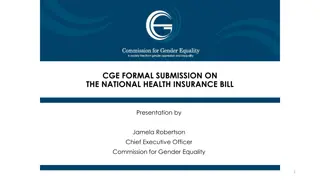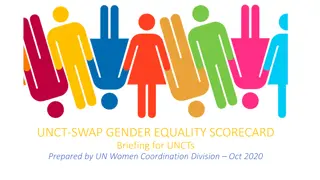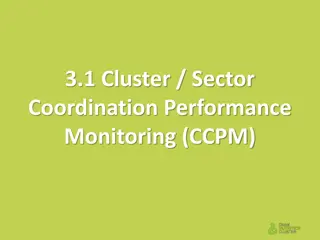Gender Equality Plans in Higher Education and Research Organizations
Structural changes resulting from gender equality plans in higher education and research organizations have been pivotal in fostering gender equity, with initiatives like ADVANCE in the USA and GERI calls in Horizon 2020 contributing to institutional change. Projects funded under SwafS in Horizon 2020 aim to convey achievements in this area, enhancing gender equality and diversity in STEM fields through tailored Gender Equality Plans.
Download Presentation

Please find below an Image/Link to download the presentation.
The content on the website is provided AS IS for your information and personal use only. It may not be sold, licensed, or shared on other websites without obtaining consent from the author.If you encounter any issues during the download, it is possible that the publisher has removed the file from their server.
You are allowed to download the files provided on this website for personal or commercial use, subject to the condition that they are used lawfully. All files are the property of their respective owners.
The content on the website is provided AS IS for your information and personal use only. It may not be sold, licensed, or shared on other websites without obtaining consent from the author.
E N D
Presentation Transcript
WHAT STRUCTURAL CHANGES ARE CAUSED BY GENDER EQUALITY PLANS IN HIGHER EDUCATION AND RESEARCH ORGANIZATIONS? Dr. Virginija idlauskien Chief Researcher, Head of the Gender Studies and Research Group International Conference Gender equality in CEE countries November 12-13, 2020, Vilnius
Back to history Since 2001 National Science Foundation (NSF) Programme ADVANCE (USA) ADVANCE contributes to organizational Change for Gender Equity in STEM Academic Professions NSF has invested over $270M to support ADVANCE projects at more than 100 institutions of higher education and STEM- related not-for-profit organizations
Strengthening the ERA Reforming and Enhancing European R&I system In 2007, under 7FP Science and Society , later Science in Society (SiS) address one of main objectives - to foster gender equality in R&I. RRI was tested and promoted during the last years of FP7. In 2010 'institutional changes' concept was firstly piloted by GenisLab and INTEGER projects by tailored GEPs
2014-2020: 'Science with and for Society' and RRI in Horizon 2020 Science with and for Society SwafS 2014- 2020 under Horizon2020: GERI calls 'Accelerating institutional change' contributes to implementing the RRI keys (ethics including research integrity, gender equality, and open access) through institutional governance changes in RPOs and RFOs in an integrated way
The aim of this presentation is to convey the achievements of gender equality projects funded under SwafS in Horizon 2020
Methological note (1) Data sources: The Community Research and Development Information Service (CORDIS) public repository with all project information held by EC such as reports, deliverables, websites, etc. Analysed 37 gender equality projects funded under the calls since the period of 2010 to 2020 projects portfolio :
GenisLab,INTEGER, FESTA, STAGES, GENOVATE, GenderTime, TRIGGER, GARCIA, EGERA, GENPORT, GENDER NET/PLUS, GENERA, LIBRA, PLOTINA, SAGE, EFFORTI, EQUAL-IST, GEDII, BALTIC GENDER, TARGET, GEECO, GENDERACTION, CHANGE, SUPERA, R&I PEERS, SPEAR, Gender-SMART, GEARING ROLES, CALIPER, CASPER, EQUAL 4EUROPE, LeTSPEPs, GRANTeD, CoP ACT, GE Academy, TARGETED-MPI
Methodological note (2) Analytical approach based on quantitative and qualitative data The analysis is carried out on desk data on currently running or completed projects under the FP7 & H2020 Programmes Each project was systematically assessed: Consortia composition and main outputs Limitation of this study is lack of complete data as many projects have not yet concluded.
# of gender equality projects in Horizon 2020, as of 15/07/2020 # of projects SwafS theme /Gender Equality Finished Running (at least 1 review held) Running (1st review to be completed) Just started (Q4 2019 / Q1 2020) TOTAL GAs signed, as of 15/05/2020 Budget Forecast of 2020 call TOTAL H2020 8 9 6 5 28 EUR 64.6 million (28 projects) 6 34
GEP implementation results (1) In H2020, excluding the 2020 call, 18 GEP projects have been funded Total budget of EUR 43.9 million (corresponding to 68% of the total budget allocated to GE projects in SwafS) EUR 34.2 million (78%) is dedicated for GEP-implementing institutions
GEP implementation results (2) 168 institutions involved in GEP projects, 130 institutions (78%) are implementing GEPs BUT among 2,725* officially recognized higher education institutions in Europe GEPs covers just 6,15 % RPOs/RFOs *(uniRank database, 2020)
Central & Eastern European Countries, CEEC: EuroVoc 17 CEE countries associated with the EU through association agreements: Estonia, Hungary, Latvia, Lithuania, Poland, the Czech Republic, Slovakia, Slovenia, Bulgaria, Romania, Albania, Bosnia- Herzegovina, Croatia, the former Yugoslav Republic of Macedonia, Kosovo, Montenegro and Serbia
Funding Scheme type: ERA-NET-Cofund 1: GENDER NET PLUS, France Research & Innovation, RIA 4: EFFORTI, GEDII, CASPER, GRANteD, coordinated by Germany, Spain, France, Austria Coordination & Support Action, CSA 32
# of projects Coordinators Spain 8 France 6 Italy 5 Germany, Austria 4 Greece 3 Sweden, Denmark, UK, Ireland, Czech Republic 1
I. Early Adopters, 30-20 Spain 28 Italy 24 Germany 20 Opinion leaders; they enjoy leadership roles, embrace change opportunities; they are aware of the need to change and are very comfortable adopting new ideas (E. Rogers typology, 2003)
II. Early Majority, 19-10 France 16 Belgium 15 UK 14 Slovenia 10 Their RPOs / RFOs match tension for change i. e. organisations have motivation and ability (E. Rogers typology, 2003)
III. Late Majority, 9-5 Czech Republic 9 Slovakia 5 They skeptical of change, and will only adopt an structural change innovation after it has been tried by the majority countries (E. Rogers typology, 2003)
IV. Laggards, 4-0 Denmark, Lithuania, Poland, Romania, Hungary, Switzerland, Norway, Israel 4 Estonia, Serbia, Iceland, Finland, 3 Croatia, Bulgaria, Bosnia & Herzegovina, Luxembourg, Canada 2 Malta, Liechtenstein, Ukraine, Morocco, Tunisia, Albania, Costa Rica, Georgia, Lebanon, US 1 Latvia 0 They are traditional and they are last to adopt changes (E. Rogers typology, 2003)
WHAT STRUCTURAL CHANGES ARE CAUSED BY GEPs IN RESEARCH ORGANIZATIONS?
Theory of change: how change occurs Funnel & Rogers, Results Chain: Inputs GEP Interventions/Activities--- Outputs/Results - --Outcomes---Impacts if we conduct A activities, to produce B outputs, in C settings, then we will produce D outcomes, which will ultimately contribute to E impacts. Outcome indicators is de facto indicators describing the real RPO/RFO changes that outputs will produce
Institutional change in: Governance, policies, rules, processes and behaviours that affect the way powers (decision making) are exercised making them more inclusive, transparent and accountable Transformation of informal norms; modification of formal institutions (such as laws and policies) (Rao; Kelleher 2005)
1st Indicator: Policies & Actions Refer to changes in terms of the incorporation of gender issues in strategic documents, the availability of resources (budget, staff, materials, time) and the existence of a gender sensitive monitoring system, among other issues
2ndIndicator: Structures & Mechanisms Obligations to gender balance in tasks, responsibilities & decision making Formal incorporation of expertise, experts & incentives and opportunities: reward system, sanctions to discourage gender biases, and equal career opportunities for women and men, etc.
Changes in Policy (1) CNRS STRIDE Committee, FR INTEGER Oder Recommendation on ensuring of equal opportunities between women and men at higher education and research institutions passed by Ministry, LT INTEGER Upsala University has developed indicators for GE, SE FESTA Extension of the Athena SWAN (UK) award scheme to Ireland, FESTA, INTEGER, GENERA
Changes in Policy (2) Marine Strategy Framework, STAGES IGAR tool, GENDER-Net Internet Portal, GENPORT A gender course module Gender and Diversity in Research Management, GENOVATE Gender Equality Network in Physics in ERA, GENERA Gender-Diversity-Index, GEDII; Policy Brief Series, GENDERACTION
Structures & Mechanisms Guideliness & Tools 28 Handbooks & books 8 Training modules, E-learning Package - 6 Studies, products: Evaluation framework, EFFORTI, SAGE Charter of Principles for Gender Equality, SAGE Wheel Model, GENERA Roadmap, Programme Theory Generator, EFFORTI, etc.) 8 Videos - 2
CONCLUSIONS (1) Less changes in institutional or national policies Obvious disparities across Member States and its raising a problem of CEEC inclusiveness in applying to Horizon Europe CEE countries and their RPO/RFO institutions less experienced and less advanced in the field of gender equality in R&I
CONCLUSIONS (2) A new ERA for Research and Innovation * is foreseeing strong measures to promote inclusive gender equality plans in R&I organisations, in line with the European Strategy for Gender Equality for the period 2020-2025, to which R&I, and Horizon Europe, must contribute actively *Communication of 30 September 2020
CONCLUSIONS (3) This new inclusive, intersectional (intersecting with gender, such as ethnicity, disability, sexual orientation or else socio-economic status) approach to gender equality is a focus area of the new EC Gender Equality Strategy is serious challenge to CEEC


